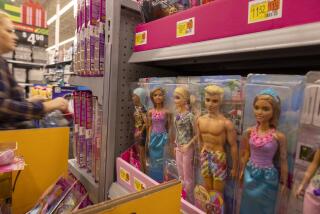Making a Play for Eager Minds
- Share via
For the last few years, LeapFrog Enterprises Inc. has been king of the pond in the electronic learning toys business.
Now, Mattel Inc. is trying to elbow its way onto the lily pad. Through its Fisher-Price division, the El Segundo company jumped in this year with its electronic read-aloud toy, the PowerTouch Learning System.
Thanks to the marketing muscle of the world’s largest toy maker, PowerTouch could pose a significant long-term challenge to the bestselling LeapPad products. That toy line, which includes several laptop-computer-like interactive book readers and a library of related software, helped Emeryville, Calif.-based LeapFrog garner close to 80% of sales in the category known as electronic learning aids. The company last year reported sales of nearly $532 million; Mattel in 2002 sold close to $4.9 billion of toys.
“There’s no question that LeapFrog has to worry about other companies’ taking share,” said toy industry analyst Sean McGowan of Harris Nesbitt Gerard in New York. “When your market share is 80%, it’s a lot easier for it to go down than to go up -- and when you go from 0% market share to 80% in essentially five to seven years, you’re the guy everyone is gunning for.”
The two companies have a good reason for targeting educational-toy spending: It totaled $800 million last year. Both are pushing their products with elaborate in-store displays and test stations.
The LeapFrog and Fisher-Price systems are made to sit on a child’s lap. Both can switch from a read-aloud mode to a phonics mode that helps the youngster sound out the words. Both are able to play learning games and offer additional lessons that quiz players in counting, spelling, letter identification and other skills.
The toys, which sell for about $40 each, scored top spots on several experts’ lists of the hottest 2003 toys, including the list of consumer guide magazine Toy Wishes.
The stakes are big enough that LeapFrog filed suit in October against Mattel, alleging that the Fisher-Price product infringed its interactive-book patents. Fisher-Price denies the charges.
“The good news for the consumer is that there are more choices,” said Warren Buckleitner, a former elementary school teacher and the editor of quarterly magazine Children’s Software Revue. The choices are inexpensive in contrast to those of a few years ago, when similar learning technology required a costly personal computer to access. “Today, you get that capability for $40 at a toy store,” Buckleitner said.
For LeapFrog, maintaining its leadership role in educational toys is crucial because that’s the company’s sole focus, said Anthony Gikas, an analyst with U.S. Bancorp Piper Jaffray in Minneapolis. Single-mindedness propelled the company’s phenomenal growth -- a 350% surge in net income last year and a 79% gain in sales. The company has sold about 14 million LeapPad platforms, Gikas estimated.
But for this year’s third quarter, LeapFrog reported sales and earnings that were far lower than expected. Although Chief Executive Michael Wood attributed that to a shift in delivery times and said the lost income would be regained during the holidays, the stock has tumbled about 40% since hitting a 52-week high of $47.30 in October, closing Friday at $27.34 on the New York Stock Exchange.
Mattel also has taken a hit, in part because consumer tastes this season have shifted away from some of the product areas the company dominates, namely dolls and cars, Gikas said. That’s why it’s important for the mature toy giant to stake a claim in fresh territory such as electronic learning devices, he added.
Neil Friedman, the president of Fisher-Price, said the division had been working on electronic learning toys for several years. The first of those efforts came last year, when the company launched Kasey the Kinderbot, an interactive robot for preschoolers that plays games designed to prepare children for school.
“We will compete and you can absolutely expect more,” Friedman said.
To meet Mattel’s challenge, LeapFrog accelerated the introduction of new toys, said Tim Bender, LeapFrog’s head of sales and marketing. The firm’s LeapPad Plus Writing, a $50 device for children 4 to 8 that helps with handwriting, wasn’t due until next year, and a new hand-held platform called Leapster originally was slated to launch in 2005.
“To me, you can either ignore the competition and act like they’re not there, or you can respond to them,” Bender said. “In our case, we got more aggressive.”
The similarities -- and differences -- between LeapPad and PowerTouch have left some parents scratching their heads. Linda Vasquez, a 30-year-old mother of two from Inglewood, already had bought the LeapPad and a few books as a Christmas present for 6-year-old Alexis and was pleased that her daughter happily played with a LeapPad at a Los Angeles Toys R Us.
But then Alexis spotted a PowerTouch and decided she liked it better because she didn’t have to use the stylus or press “Go” to let the system know which page she was on -- something she sometimes forgot to do on the LeapPad, she said.
“It’s easier,” Alexis said, leaving her mother in a quandary just days before Christmas.
More to Read
Inside the business of entertainment
The Wide Shot brings you news, analysis and insights on everything from streaming wars to production — and what it all means for the future.
You may occasionally receive promotional content from the Los Angeles Times.










